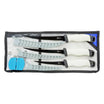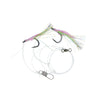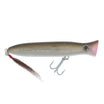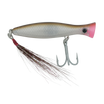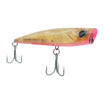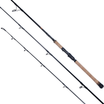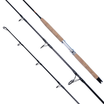The unique advantages of needlefish and swimming plugs can significantly impact your success. Needlefish lures, known for their slim profiles and subtle surface action, excel in calm conditions and when targeting finicky fish that are feeding near the surface. In contrast, swimming plugs offer a more pronounced, wobbling motion, making them ideal for rougher waters and active feeding scenarios.
This guide will help you determine when to use each type, enhancing your fishing strategy and increasing your chances of a successful catch.
Needlefish Lures:
Profile and Action: Needlefish lures are slim and elongated, designed to mimic slender baitfish like sand eels. They create minimal splash and a subtle surface wake.
Usage Scenarios:
Calm Conditions: Ideal for calm water when fish are feeding near the surface.
Finicky Fish: Effective when fish are wary or pressured, as their subtle action can entice reluctant bites.
Long Casting: Excellent for reaching distant fish due to their aerodynamic shape and solid core bodies.
Swimming Plugs:
Profile and Action: Typically have a more substantial, wobbling action, imitating a broader range of baitfish with a more pronounced swimming motion.
Usage Scenarios:
Choppy Conditions: Better suited for rough or choppy waters where their action stands out.
Active Feeding: When fish are aggressively feeding, the pronounced wobble and flash of swimming plugs can trigger strikes.
Versatile Depths: Effective across various depths, depending on the plug's design.
Key Differences:
Subtlety vs. Action: Needlefish are for subtle presentations, while swimming plugs offer a more aggressive, noticeable action.
Condition Adaptability: Choose needlefish in calm, clear conditions and swimming plugs in rougher, more turbulent waters.
When to Use a Needlefish Over a Swimming Plug
- Calm, Clear Open Water
Situation: Fish are often extra wary when water is calm and clear.
Why Needlefish: Needlefish lures have a subtle action and slim profile that is less likely to spook fish in these conditions, making them ideal for a stealthy approach.
- Night Fishing Imitating Eel
Situation: Targeting nocturnal feeders like striped bass during the night, cruising beaches looking for prey.
Why Needlefish: Needlefish lures can mimic the silhouette of an eel or other prey in low light, and their subtle movement is more effective in the darkness, where fish rely more on vibration and less on sight.A long, oversized plug flag in a dark color will add a “serpentine” action with each subtle wobble of the needle fish.
- Imitating Sand Eels
Situation: Fish are feeding on slender baitfish like sand eels.
Why Needlefish: The slim, elongated profile of a needlefish lure perfectly matches the shape and size of sand eels, increasing the likelihood of a strike of finicky fish. Large, heavy needle fish are highly underrated offshore when targeting tuna.
- Long-Distance Casting
Situation: You need to cast your lure a long distance to reach fish, beach or moving fish.
Why Needlefish: Needlefish lures are typically more aerodynamic and heavier with their solid core, allowing for longer casting distances, which is essential for reaching fish that are farther away.
When to Use a Swimming Plug Over a Needlefish
- Choppy Waters or Surf
Situation: Fishing in turbulent water conditions.
Why Swimming Plug: Swimming plugs are designed to swim down a few feet, which gets them under the turbulent water, maintaining a consistent action that attracts fish even in choppy conditions.
- Imitating Bigger Baitfish
Situation: Targeting predators feeding on larger baitfish like menhaden, herring, or mackerel.
Why Swimming Plug: The larger profile and wobbling action of swimming plugs make them ideal for mimicking these bigger baitfish, appealing to larger predators.
- Fishing Around Boulder Fields
Situation: Fishing in areas with lots of underwater structures that could cause snags.
Why Swimming Plug: The continuous action of a swimming plug helps avoid snags since you don’t have to pause your retrieve, reducing the risk of getting caught on boulders or other structures.
- Need a Faster Retrieve to Trigger a Reaction Strike
Situation: When fish are actively feeding and you need to provoke a reaction strike.
Why Swimming Plug: Swimming plugs can be retrieved quickly while maintaining their action, triggering aggressive strikes from predatory fish that are chasing fast-moving prey.




















